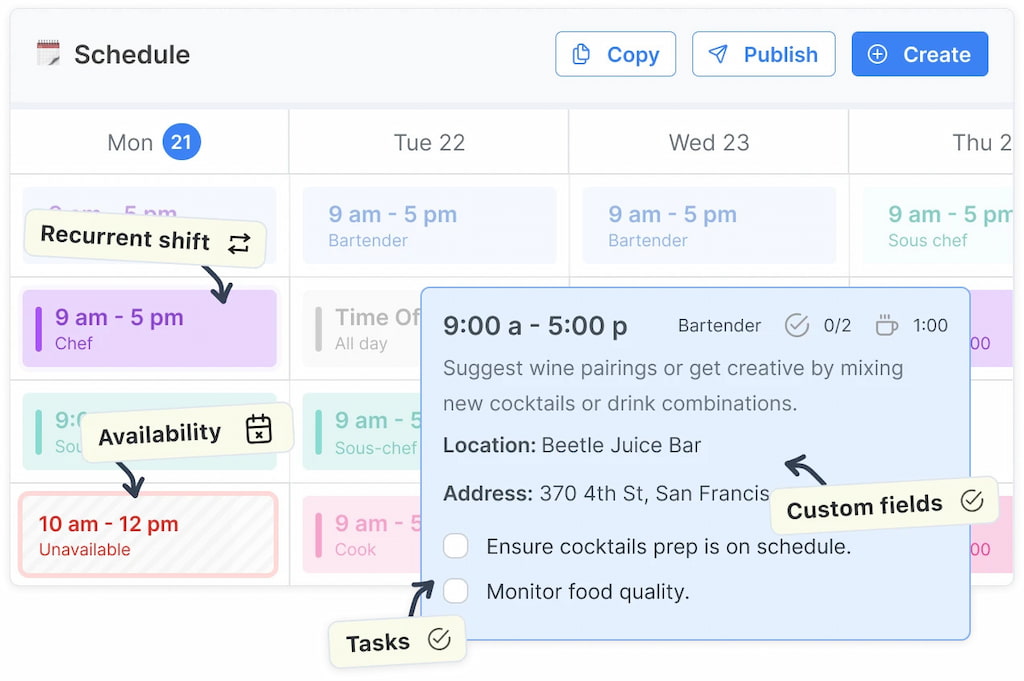Call Center Automation Software: 2025 Guide to Choosing the Best Call Center Scheduling Software

The Monday morning spike hits: chats surge, phones ring nonstop, and emails pile up. Half your agents are busy, a few are training, and some are out—who handles VIP callbacks or lunch coverage? “Work harder” won’t solve this; smart scheduling and automation will. In this 2025 guide, learn what call center automation software really does, how to choose the right platform, which features matter at different maturity stages, and how top scheduling tools keep service levels steady without burning out your team. Time and workload visibility help you forecast, staff smarter, and protect CSAT.
Make sure to check out free employee shift scheduling apps that can also help with call center automation, in regard to scheduling, more specifically!
What Is Call Center Automation Software?
Call center automation software removes repetitive, rules-based work from agents’ hands and routes customer requests to the right place—fast. It usually sits inside or alongside a broader CCaaS (Contact Center as a Service) platform and includes:
Key capabilities
- Intelligent routing & IVR – Automatically direct customers based on intent, language, or priority.
- Chatbots & virtual agents – Deflect common questions, collect details, and escalate with context.
- Agent assist – Live guidance, scripting, suggested replies, and knowledge surfacing inside the agent desktop.
- RPA (robotic process automation) – Move data between systems, update orders, or trigger workflows after calls or chats.
- Quality management & analytics – Auto-score interactions, spot coaching moments, and surface trends.
- Knowledge management – Centralize answers; use search and AI to deliver the right snippet at the right second.
- Workforce tools – Forecast demand, schedule agents, monitor adherence, and optimize intraday changes.
- Integrations – Connect CRM, ticketing, e-commerce, billing, and identity platforms so context follows the customer.
🤔 Why it matters in 2025
Customers expect real-time answers across voice, chat, SMS, social, and email. Agents want intuitive tools and doable workloads. Leaders want measurable gains in service level, FCR (first contact resolution), AHT (average handle time), and cost per contact.
Automation delivers all three: it handles predictable tasks at scale and frees humans for the nuanced work only they can do.
Core Capabilities to Evaluate
Use this checklist to quickly scan key features of call center automation and WFM tools.
⚡ Automation layer
✅ Omnichannel routing – Voice, chat, email, SMS, and social queues with skill, sentiment, and priority logic.
🤖 Conversational AI – No-code bot builder, NLU, intent training, and smooth human handoff.
💡 Agent assist – Real-time hints, macros, knowledge surfacing, compliance prompts.
🔄 After-call automations – Post-interaction tagging, dispositioning, CRM updates.
📊 QA & coaching – Auto-scoring, calibration, and structured coaching plans.
📈 Reporting & analytics – Real-time dashboards, historical reports, BI connectors.
📅 Scheduling (WFM) layer
📉 Forecasting – Multi-channel, multi-skill forecasts with range scenarios and seasonality.
⏱ Advanced scheduling – Rotations, split shifts, shift bidding, part-time patterns, PTO management.
📌 Adherence & intraday – Real-time monitoring, re-forecasting, dynamic reskilling, break/lunch balancing.
🛡 Shrinkage modeling – Training, PTO, meetings, buffers baked into headcount plans.
⚖ Compliance – Labor/union rules, regional rest & meal requirements.
📱 Agent self-service – Shift swaps, PTO requests, mobile app, notifications.
The Best Call Center Automation Software (2025 Snapshot)
| Tool | Focus | Standout features | Pricing approach | Ideal fit |
|---|---|---|---|---|
| Five9 | Enterprise CCaaS | Predictive dialer, IVA, agent assist, WEM | Tiered per-seat + usage | Mature phone-heavy teams scaling globally |
| Genesys Cloud CX | Enterprise omnichannel | Journey routing, bots, WEM, analytics | Per-user tiers + add-ons | Large multi-skill, multi-region contact centers |
| Talkdesk | CCaaS + AI | Studio workflows, AI Knowledge, WEM | Per-seat tiers | Fast-growing teams wanting quick deployment |
| Amazon Connect | Cloud-native | Pay-as-you-go telephony, Lex bots, open integrations | Consumption-based | Builders with dev resources, flexible costs |
| Zendesk Suite | Service + messaging | Ticketing + channels, bots, agent workspace | Per-agent tiers | Support orgs living in ticket workflows |
| Aircall | SMB voice + helpdesk integrations | One-click routing, call analytics, app marketplace | Per-seat tiers | SMBs moving from legacy PBX |
| RingCentral Contact Center | UCaaS + CCaaS | Voice, messaging, WEM, native telephony | Per-seat tiers | Orgs consolidating telephony and contact center |
| Intercom | Conversational support | Bots, Fin AI, help center, handoff | Per-seat + resolution-based | Digital-first teams prioritizing chat/messaging |
The Best Call Center Scheduling Software (WFM) in 2025
| Tool | Focus | Standout features | Pricing approach | Ideal fit |
|---|---|---|---|---|
| NICE WFM | Enterprise WFM | Multi-skill forecasting, real-time adherence, AI scheduling | Custom | Large, complex operations |
| Calabrio WFM | Enterprise WEM | Intraday automation, analytics, QM integration | Tiered | Mid-to-large omnichannel centers |
| Verint WFM | Enterprise WEM | Compliance controls, advanced forecasting, performance hub | Custom | Regulated industries at scale |
| Playvox WFM | Modern WFM | WEM suite incl. QA/coaching, easy intraday | Per-seat tiers | Digital-first teams and BPOs |
| Assembled | Modern WFM | Speedy forecasting, simple schedules, Slack alerts | Per-seat tiers | SaaS support teams growing fast |
| Injixo | Cloud WFM | Forecasting, adherence, long-range planning | Tiered | Multi-site teams needing strong forecasting |
| Genesys WEM | Vendor-native | Tight with Genesys routing and analytics | Add-on | Genesys Cloud CX customers |
| Shifts by Everhour | SMB scheduling | Drag-and-drop shifts, mobile app, labor rules, self-service | Free + paid plans | Small to midsize support desks and hybrid teams |
Why Shifts by Everhour
When your team is small to midsize or hybrid (support plus back-office work), a heavy enterprise WFM may be overkill. Shifts by Everhour gives you manager-friendly scheduling with rule-based constraints, self-service swaps, and a mobile app—without burying you in complexity. It’s well-suited for support teams that need fast schedule creation, quick adjustments when someone calls in sick, and clean visibility for agents.

How Automation and Scheduling Work Together
Think of it as supply and demand:
- Automation shapes demand – bots deflect FAQs, IVR directs intent, and agent assist shortens handle time.
- Scheduling supplies coverage – forecast the remaining human work, place the right skills at the right time, and flex intraday when reality beats the plan.
⚡ A practical example
- 🕙 10 a.m.–2 p.m. returns peak – chatbots capture order IDs, check statuses, and gather disposition.
- ☎️ IVR routing – warranty calls go to specialized skills; simple serial-number checks get self-service paths.
- 💡 Agent assist – suggests knowledge articles for tier-1 support.
- 📊 Forecasting – accounts for residual human contacts and shrinkage (breaks, coaching, training).
- 🔄 Intraday management – adds a micro-shift when a promo email unexpectedly spikes volume.
- 📈 Post-day analytics – update next week’s forecast and coach for QA gaps identified by auto-scoring.
Feature-by-Feature Buyer’s Guide
🎯 Routing and capacity
- Skills & proficiency – Can you model them?
- Intent & sentiment routing – Is it supported?
- Overflow & VIP handling – How are callbacks and special cases managed?
🤖 Bots and self-service
- No-code bot builder – Multilingual NLU support?
- Smooth handoff – Do transcripts, metadata, and context carry to agents automatically?
🖥️ Agent workspace
- Consolidated view – All channels and CRM in one place?
- Real-time assist – Snippets, macros, and policy alerts?
- Efficiency & accessibility – Keyboard-first workflows, accessibility controls?
📊 Quality and analytics
- Auto-QA & topic detection – Scorecards and calibrations included?
- Reporting – Real-time dashboards, historical reports, export/BI options?
📅 WFM depth
- Forecasting – Across voice, chat, email, with interval granularity?
- Adherence & intraday – Re-forecasting and coverage adjustment?
- Shift flexibility – Time-off bidding, rotas, part-time/flexible patterns?
🔗 Integrations and data
- Native connectors – CRM (Salesforce, HubSpot, Zendesk, Freshdesk), commerce, billing, identity?
- APIs & event streams – For custom analytics and workflows?
🔒 Security and compliance
- Access control – Role-based, SSO/SCIM, data residency options?
- Audit & encryption – Logs and encryption in transit/at rest?
💰 Pricing notes
Vendors price CCaaS and WFM via per-agent licensing, usage (minutes/messages), or a mix. Add-ons often apply for WEM modules (QA, coaching, WFM), automation/bot capacity, recordings, and analytics. Always model a realistic month—including seasonality, overtime, and planned promos—before committing.
Implementation Blueprint (First 90 Days)
⚙️ Days 0–30: Foundations
- Map the journeys you’ll automate first: password resets, order tracking, returns, appointment changes.
- Define your routing plan: skills, priorities, and service goals per channel.
- Stand up your initial bot/IVR with guardrails and fast human handoff.
- Import or build your knowledge base “minimum viable corpus.”
- Configure Shifts by Everhour (or your chosen WFM): staffing groups, rules, rotations, and PTO policies.
📈 Days 31–60: Expand and train
- Extend bots to two or three high-volume intents with human-reviewed training sets.
- Turn on agent assist for targeted queues.
- Roll out QA scorecards with two high-impact behaviors (e.g., verification, empathy).
- Refine the forecast based on observed volume and handle time; tighten adherence targets.
- Launch agent self-service: PTO requests, shift swaps, and mobile notifications.
📊 Days 61–90: Optimize and measure
- Add callbacks and virtual hold for voice peaks.
- Introduce intraday playbooks: re-skill plans, voluntary time off/on, and meeting deferrals.
- Close the loop with weekly analytics: SL, AHT, FCR, deflection, bot containment, schedule adherence, occupancy, and shrinkage.
- Create a coaching cadence: auto-QA picks, targeted 1:1s, and shared wins.
- Re-forecast the next quarter using trends and planned campaigns.
Troubleshooting: When Automations Misbehave
- ⚡ Triggers not firing – Check intent confidence thresholds, channel permissions, or bot fallbacks.
- 🔄 Handoffs losing context – Verify transcript pass-through and CRM session mapping.
- 🔁 Routing loops – Review queue order and skills precedence; add “escape routes.”
- 🤖 Bot performance dipped – Retrain intents with fresh examples; add clarifying questions.
- 📊 Reporting gaps – Confirm agent states are mapped consistently across channels and WFM.
- ⏱ Adherence alarms – Align aux codes (break, meeting, after-call work) across systems.
Operational Best Practices (That Actually Work)
- 📄 One-page playbooks – For each top 5 contact reason, define bot steps, agent flow, and escalation rules.
- 📊 Forecast in ranges, schedule in confidence – Plan for P50–P90 scenarios and keep a small intraday bench.
- ⏱ Protect occupancy – Sustained 90%+ occupancy burns people out; balance SL with recovery time.
- 📚 Build knowledge like a product – Short, single-purpose articles, clear versioning, and quick feedback loops.
- 🎯 Coach on one behavior at a time – Quality sticks when focus is tight and practice is frequent.
- 🔧 Instrument everything – Track deflection, containment, and human-assisted outcomes; use those signals to improve both automation and staffing.
Best Call Center Scheduling Software Deep-Dive: Picking What Fits
🌐 Enterprise complexity (Global, regulated, multi-brand)
- Favor NICE, Verint, or Calabrio for robust forecasting, intraday automation, and tight QA/WEM alignment.
- Look for strong what-if modeling and long-range planning for seasonal swings.
🚀 Digital-first growth teams
- Playvox, Assembled, or Genesys WEM often wins for speed to value and lightweight admin.
🏢 Small to midsize support desks and hybrid teams
- Shifts by Everhour provides fast shift creation, manager-friendly templates, rule-based validations, and an intuitive mobile app for agents. Ideal if your team handles calls plus chat/email and needs reliable coverage without enterprise WFM overhead.
Clean Decision Framework (In 7 Steps)
- Define your “jobs to be done” – Set deflection goals, service level targets, channels, and compliance constraints.
- Map your ecosystem – Include CRM, e-commerce, identity, billing, data warehouse, and HRIS.
- Shortlist platforms – Pick 2–3 automation platforms and 1–2 scheduling tools aligned with your size and team skills.
- Run task-based demos – Have vendors implement your top two real journeys (e.g., returns + password reset).
- Model total cost – Factor in licenses, usage, add-ons, implementation, and change-management effort.
- Pilot, don’t boil the ocean – Start with one region or queue; measure and iterate.
- Operationalize – Assign owners for knowledge, bots, routing, WFM, QA, and analytics. Put cadences on the calendar.
FAQs
What is the difference between “call center automation software” and “contact center software”?
Contact center software is the platform for all channels. Automation software is the layer—often built-in or modular—that routes, deflects, and accelerates work. You’ll usually evaluate them together.
What’s the best call center scheduling software for a small business?
If you’re under ~50 agents and need quick deployment, Shifts by Everhour can be a practical, affordable fit with drag-and-drop schedules, rule validations, and mobile self-service. If you’re planning rapid growth and multi-site forecasts, consider Assembled or Playvox.
Can bots replace agents entirely?
No. Bots are fantastic at repeatable, predictable tasks. Humans shine at exceptions, emotion, and complex reasoning. The best operations pair the two and route by intent and value.
How do I avoid “automation gone wrong”?
Make human handoff simple and fast. Keep bot answers short, verifiable, and linked to knowledge. Monitor containment with customer-centric metrics—not just cost.
Should WFM live inside my CCaaS or as a separate tool?
If you’re small or mid-market with straightforward queues, built-in WFM can be enough. At enterprise scale or with complex, multi-skill networks, a dedicated WFM often pays for itself in better forecasting and intraday control.
Which KPIs matter most?
Balance speed, quality, and people: Service Level, FCR, AHT, CSAT/NPS, Deflection/Containment, Adherence, Occupancy, and Shrinkage. Track them together to avoid local optimizations that hurt the whole.
How long does implementation take?
Small teams can stand up basic channels, a few bot intents, and simple schedules in weeks. Complex, regulated centers should plan phased rollouts over one to three quarters.
Final Thoughts
Today’s customers move seamlessly between chat, voice, email, and social. They expect your brand to move with them. Call center automation software helps you deliver instant answers; the best call center scheduling software ensures the right humans are there for everything else. Put them together and you get a resilient operation—one that deflects the simple, accelerates the complex, and protects the people doing the work.
Start small: automate one high-volume journey, publish a clear schedule with self-service options, measure outcomes, and iterate. Within a quarter, you’ll feel the difference in your queues, your KPIs, and your team’s energy. And that’s the point—great tools should make great service feel sustainable.
If you’re looking for a seamless way to improve shift planning, Shifts by Everhour is the perfect solution. With this best resource scheduling software, managing your workforce has never been simpler.
If you want more industry-specific scheduling options, check out our list of the best security guard scheduling software or the best healthcare scheduling software systems!
